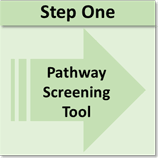Renewable Fuel Petition Review Process
The purpose of the petition review process is for EPA to analyze the lifecycle greenhouse gas emissions associated with new fuel pathways to determine whether they meet the reduction thresholds for qualification. The length of EPA's review depends on the type of analysis required to evaluate the requested pathway and the quality of the petition submitted. This page discusses the typical steps in the petition process and how they vary for different types of petitions.

- Petitioner submits the Pathway Screening Tool.
- EPA provides input on preparing the petition.
- EPA may find that a petition is not needed.
- Petitioner reviews details on how to submit a petition.
- Based on input from EPA, petitioner prepares and submits a petition.
- EPA reviews petition for completeness.
- EPA asks for additional information if needed or rejects if incomplete.
- After accepted as complete, EPA prioritizes for analysis.
- EPA conducts a lifecycle greenhouse analysis.
- EPA seeks public comment as appropriate.
- If approved, petitioner begins registration.
1. Pathway Screening
- The petitioner uses the Pathway Screening Tool.
- Parties considering a new pathway petition are strongly encouraged to use the Pathway Screening Tool.
- The tool is intended to save fuel producers and the Agency time, because it gives the EPA the opportunity to review basic information about a proposed pathway and respond with questions or input before a party begins preparing a petition.
- EPA provides input on preparing a petition and how it would likely be prioritized for analysis.
- Based on the information provided through the Pathway Screening Tool and any subsequent correspondence, if the EPA finds a petition is warranted the Agency will provide input on what type of petition should be prepared and whether there are areas for special attention. This may be an iterative process, including multiple requests from EPA staff for more information.
- Parties who do not use the Pathway Screening Tool and jump directly to submitting a petition will not receive EPA's input at this stage, which may cause significant delays or other complications.
- See Step 3 (Petition Review and Prioritization) for more information on the criteria for prioritizing petitions.
- EPA finds a petition is not warranted.
- Based on the information provided through the Pathway Screening Tool and any subsequent correspondence, the EPA may find that a petition is not needed for a number of potential reasons, including the following:
- The fuel pathway may already exist, meaning the fuel producer can begin the registration process for the existing pathway.
- The proposed fuel pathway may be ineligible for qualification as renewable fuel if the feedstock does not qualify as renewable biomass; the fuel is not transportation fuel, heating oil or jet fuel; or the proposed pathway does not align with other requirements in the RFS regulations.
- The proposed pathway may include an element that EPA is not equipped to address through the petition process because it involves fundamental issues that, for example, can only be resolved through major changes to the RFS regulations or, as another example, involves a technology that is not sufficiently mature to be analyzed by the EPA.
- Based on the information provided through the Pathway Screening Tool and any subsequent correspondence, the EPA may find that a petition is not needed for a number of potential reasons, including the following:
2. Petition Submission
- After the EPA provides guidance on the type of petition that should be prepared, the petitioner is ready to prepare a complete petition.
- In preparing a complete petition, parties are strongly encouraged to review EPA's web page on how to submit a complete petition, which includes important information on what type of information to include, the format and organization of the application package, and the steps for delivering the petition to the Agency.
3. Petition Review and Prioritization
- EPA reviews the petition for completeness.
- When the package is received by the EPA, staff will acknowledge receipt and begin to review it for completeness.
- If EPA receives a petition that does not meet the basic information requirements (e.g., a whole category of required information is missing) the Agency will notify the petitioner and take no further action. This notification will typically be very brief, as Agency staff may not review the entire package once a section has been found to lack basic information.
- As part of the review process, EPA staff may request additional information that will need to be addressed by the petitioner. The EPA will send information requests in writing, at which point the petitioner will have 30 calendar days to respond with an addendum to the original submission. If EPA's requests are not addressed within this period, the petition will be rejected as incomplete and resubmission of the entire package will be required.
- If the EPA finds that the application package is complete, the EPA will notify the petitioner and list the petition on the EPA website as pending analysis.
- Petitioners should be aware that during the analytical stage of the process, the EPA may have additional clarifying questions that will require responses from the petitioner in a timely manner.
- EPA prioritizes the petition for analysis.
- Considering resource limitations, the Agency needs to set priorities with respect to petition reviews. Consistent with statutory intent and our experience to date, we believe petitions for new fuel pathways can be prioritized based on the following criteria:
- Ability to contribute to the cellulosic biofuel mandate.
- Potential for reducing greenhouse gas emissions on a per gallon basis, for example by using feedstocks that likely do not have significant indirect land use change emissions. In particular, non-food feedstocks would be prioritized under this criterion.1
- Ability to contribute to near-term increases in renewable fuel use. This criterion would include, for example, consideration of the ability of the intended biofuel product to be readily incorporated into the existing fuel distribution network. In particular, drop-in biofuels would be prioritized under this criterion.2
- Petitions that are similar based on the above criteria will be further prioritized based on closeness to commercialization and the date that a complete petition is submitted.
- Considering resource limitations, the Agency needs to set priorities with respect to petition reviews. Consistent with statutory intent and our experience to date, we believe petitions for new fuel pathways can be prioritized based on the following criteria:
4. Lifecycle Analysis and Determination
- The steps and length of the lifecycle analysis and determination stage depends on the type of proposed fuel pathway under consideration. General information is provided below on how different types of petitions are likely to be evaluated.
- If a petition is appropriately submitted through the Efficient Producer petition process, the EPA will conduct an expedited review and a standard company-specific determination document will be signed by the Director of EPA's Office of Transportation and Air Quality, delivered to the petitioner electronically, and posted on the EPA website.
- If the proposed pathway represents a slight modification from an existing pathway, such that the determination can rely on a straightforward extension of EPA's previous assessments for most portions of its lifecycle analysis and no significant new policy issues are apparent, then the review and approval process will typically include the following steps:
- The EPA conducts a lifecycle greenhouse gas analysis, drafts a pathway approval document and shares it with the petitioner to assure the determination is a fair representation of the petitioned process and that the draft document contains no confidential business information.
- The petitioner signs and returns the confidential business information waiver provided by the EPA.
- The company-specific determination document is signed by the Director of EPA's Office of Transportation and Air Quality, delivered to the petitioner via email and mail, and posted on the EPA website.
- If the proposed pathway is similar to previously evaluated pathways but requires significant new modeling or analysis using EPA's existing modeling framework and methodology, then the review and approval process will typically include the following steps:
- Technical information on the lifecycle analysis is prepared and published for public comment (a 30 day comment period is standard).
- After considering comments and amending the analysis as appropriate, EPA drafts a company-specific pathway approval document,3 including responses to the public comments, and then follows the other steps outlined above in 4(C).
- If the evaluation and/or implementation of the proposed pathway requires EPA to develop a new modeling structure or methodology or substantial regulatory changes, then the petition will need to be resolved through a rulemaking process.



